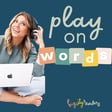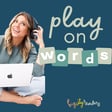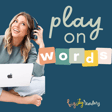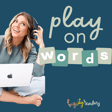Become a Creator today!Start creating today - Share your story with the world!
Start for free
00:00:00
00:00:01

How Do I Teach My 4 Year Old Vowel Sounds?
Help! My 4 year old is really getting consonant sounds but struggles with vowel sounds and I think I do too. What's long and short and what do I teach her first?
This episode answers this parent question and touches on beginning to blend. You'll hear how to say each vowel sound, when it's appropriate to expect understanding and best developmentally appropriate practices for working on this concept daily.
Read the blog: bigcityreaders.com
Show notes: bigcityreaders.com/podcast
Follow me: Instagram.com/bigcityreaders
Transcript
Introduction & Format Update
00:00:01
Speaker
Hello, my friends. Welcome back to the Play On Words Podcast. It's your host, Ms. Beth. Wow. The last four months, I feel like, have been such a whirlwind. This episode is going to be taking it back to
00:00:18
Speaker
the original style of the podcast that I'm hoping to get more time to do.
Listener Questions & Engagement
00:00:24
Speaker
I've had so many fantastic guests and longer form interviews on the podcast and I love doing that. But what I really would love to get back to is sharing weekly, just a really specific
00:00:38
Speaker
question that real parents ask and a real quick answer that you can implement by the end of the day. So this also goes for teachers too. Of course, anything that a teacher can implement in the classroom, a parent can try at home and vice versa. But I'm excited to get back to answering your questions. I have a list of about 300 questions that you have asked.
00:01:04
Speaker
So, plan for at least 300 more episodes.
Updates & Resources
00:01:08
Speaker
Of course, if you have any question, no matter how specific it is, please reach out and email or send a message on Instagram, bigcityreaders, or email hello at bigcityreaders.com.
00:01:23
Speaker
And check out my blog on bigcityreaders.com. You can see, I'm bringing that back too. So you can see a lot of the topics that we talk about here in a written format if you prefer to read things. So a lot of things are coming back full swing this spring. And I'm so excited to hopefully help you at home or in your classroom. So let's dive into this week's question.
How to Teach Vowel Sounds?
00:02:02
Speaker
So this week someone asked, can you help me with vowels? Vowel sounds seem to be really tricky or my four-year-old who knows most of her consonants but struggles with vowels. Okay, first of all,
00:02:21
Speaker
your four-year-old knowing most of their consonants is an amazing thing in itself. So let's just celebrate that because it is totally developmentally appropriate to even start kindergarten not knowing all of your sounds. And the vowels are tricky for kids even in first and second grade. So you haven't even started kindergarten yet and you're already
00:02:48
Speaker
helping your child with this. So I hope that you really, really know that that is a huge thing to celebrate. And they are right on track or beyond where they need to be. So your child does not need to master vowel sounds yet. But if they're showing interest and you're getting ready to start reading some CVC words, that stands for consonant, vowel, consonant. And there's another episode,
00:03:17
Speaker
that I talk about this, but CVC words are usually where we start when we're teaching kids to read. We don't have to wait until kids know all of the letters to start teaching them to blend and build words. If you took my ABC workshop last month, I talked about this, that you can teach six letters and have a solid understanding of those six letters and sounds and teach them
00:03:45
Speaker
how to blend and build words and start to build reading confidence. I showed you a lot of strategies and tools to do this, but one big thing I like to remind parents and teachers is that it is so much better to have a solid understanding of 10 letters and sounds.
Techniques for Teaching Vowels
00:04:04
Speaker
That means looking at them in all kinds of fonts, recognizing them uppercase and lowercase,
00:04:11
Speaker
being able to build them, whether that's writing them or if your hands aren't strong enough to write them yet, building them with Play-Doh or blocks, and knowing the sound and reverse when the sound is said, knowing that the letter, which letter represents that. So naming it, naming the letter, naming the sound, recognizing it in lots of different fonts, knowing it uppercase and lowercase, it is so much better, in my opinion, to know solidly, no,
00:04:42
Speaker
six letters and sounds than just sort of know all of them inconsistently. So that's my one piece of advice there. Number two, vowels are tricky. That is just, it's just it. So expect your child to struggle with vowels. Even I see so many adults struggling with vowels
00:05:10
Speaker
I hear people say, yeah, there's the letter A, like ah. And sure, sometimes it does say that sound, but when we're teaching beginning readers the vowel sounds, I like to start with the typical short vowel sound. So that would be A is ah, E is eh, I is ih, O is ah, U is uh. Now, of course we have Y, but this is where I start with
00:05:39
Speaker
This, this is where we start with four and five year olds. Um, very, very beginning. We can get into that once they demonstrate that they're having understanding of how we're building words and blending words and that a word needs to have a vowel in it or a syllable needs to have a vowel in it too. So that being said, some things that you can help your child with, with vowels are make it
00:06:01
Speaker
multisensory. So the more senses we can incorporate, the more connections we can make. So that doesn't mean you need to have a bowl of rice for your child to write their letters in, although if they're interested in that, great. But multisensory can mean saying it while you're looking at it and hearing it and also tracing it in the air or writing it in the carpet. So
00:06:30
Speaker
I would say pick one each day. So I'm not a big fan of letter of the week, but I like letter of the day and know that they're going to be tricky, especially at age four, but it's going to be tricky for your child to understand the differences. So I would pick one and talk about that one and help them draw attention to hearing the sound in the middle of words. So like I might say pit in.
00:07:00
Speaker
sit and have them touch their head every time they hear the it sound. And I might hold the letter I in front of them or give them a card or like a piece of paper, a post-it, whatever you have that has the letter I on it and explicitly say, this is the letter I, the sound is it. Repeat after me. This is the letter I, the sound is it. And every time you say a word that has it
00:07:30
Speaker
in it, they're going to lift that card up and say, eh. Or you can say, this is the letter I, the sound is eh, and maybe change up your voice. Maybe you say it really loud, and then they repeat it back to you. This is explicit instruction. We're explicitly saying, this is the letter, this is the sound. And they're confirming that. I also like to add
00:07:57
Speaker
little gestures. So another thing you can do is add little gestures. So for A, I might open my mouth because the sound, ah, I like to say is kind of like the sound or our mouth shape is going to be like we're going to take a big bite of an apple. So I open my hand next to my mouth, like I'm taking a
Reinforcing Vowel Sounds Daily
00:08:23
Speaker
bite of an apple, ah.
00:08:25
Speaker
Again, I'm going to have the letter A in front of me while I'm doing this. You could also put your hand or your finger under your chin and say this short vowel sound makes our chin come down. So again, we were showing our mouth opened. You could also make it show that your chin comes down and push against your hand. And then repeat that a lot. I
00:08:51
Speaker
probably with age four would not do all of the vowel sounds at the same time. I might really help them feel confident with one or two in a day and then repeat that for a little while and then introduce other ones. You know your child best, so you'll be able to tell if they're understanding it or if they're overwhelmed. But I like to keep this practice short and sweet. So maybe you do it for three minutes and then end on a high note, be done.
00:09:21
Speaker
bring it back around maybe at dinnertime, same vowels that you talked about at breakfast, and do two or three more minutes, have fun, make it silly, and then be done again. Like leave them wanting more. For the, okay, so I'll give you some cues that you can do. So for A, that's what I would do. For E, I take two fingers, like a thumb and your index finger,
00:09:50
Speaker
And I put them on each of the corners of my mouth. And then you're going to say the sound as you kind of push back your lips in those corners toward your ears. Eh, eh. The letter is E, the sound is eh. For I, I like to pretend I have an itch on my nose. So wrinkle your nose and take your pointer finger and say, eh, eh, eh, itch. I says, eh, eh.
00:10:20
Speaker
I, I. For the short vowel sound, O, like in the word pot, I like to say, have you ever had to go to the doctor and they want to look in your mouth? They say, open up your mouth and say, ah. And then I draw a circle with my finger around my mouth. And I say, look at this sound that you're making is also the shape that the letter O is.
00:10:50
Speaker
So, ah, O says, ah. And then for the short vowel U, I like to take, you can either just take your hand or make a U with your hand and gently hit your chest and say, ugh, like kind of the sound you make when you get hit in the stomach or the chest, ugh.
00:11:14
Speaker
And of course, we want to set appropriate boundaries around this. We don't want kids hurting themselves, model how to do these things gently. And I would practice these exercises every day. So after you've introduced these vowel sounds, and maybe you've practiced two a day, two a day, two a day, two a day, two a day for two weeks, then I'm going to practice them every
When to Teach Long Vowel Sounds?
00:11:39
Speaker
day. And this is just something really short you can do.
00:11:43
Speaker
Post-its in the car that have each of these letters so either the written in uppercase or lowercase and then you can say just say short CVC words or If your child's ready for multisyllabic words, you can say bigger words, but have them hold up while you're driving or
00:12:04
Speaker
doing any like making dinner activity and just do two minutes of calling out words and have them hold up the post-it of the vowel sound they hear in that word. So this is a really great way to start practicing introducing the short vowel sounds, but also know that at age four, it's really typical to be struggling with these vowel sounds. And it's normal even in kindergarten and first
00:12:30
Speaker
grade, but this is what I would do. This is some explicit instruction on vowel sounds. Remember, it does not have to be that complicated. Just say, this is the letter. This is the sound. And I like to do, I do, we do, you do. And kids love this. It's kind of like follow the leader. So have them listen to you. This is the letter I. This sound is I. We do. We both say it. This is the letter I. This sound is I.
00:12:59
Speaker
You do, they say it. This is the letter I, the sound is it. As your child gets more comfortable and confident with this, you can play games like, I spy with my little eye something that starts with it, or something that has an it inside of it. And of course, that is a much higher level than this beginning stage for four year
Engagement & Feedback Invitation
00:13:23
Speaker
olds. But this is just some differentiation you can
00:13:26
Speaker
have if you've got, you know, second graders and preschoolers with you that you're practicing letter games with. These are, these are some fun things to do. Long vowel sounds are going to come much later. This is going to be what you're going to start with. Long vowels typically follow a progression of when we know kids are ready to be introduced to long vowel patterns. And for a lot of kids that will come end of kindergarten or early first grade.
00:13:53
Speaker
But again, it depends on the child and what they're understanding and showing mastery in. And that's what I would follow. I would follow their lead. So it's not like they should know this at a certain time. If it hasn't been introduced, we can't really expect that they would understand this. So I only hold kids accountable to the things that they have been explicitly taught. If you want to see a video of me saying all of the letter sounds, you can go to YouTube and look up big city readers.
00:14:22
Speaker
or go to my Instagram, Big City Readers, and I have a couple of videos pinned saying the beginning letter sounds that I introduce to kids that are ready to learn the letter sounds. I also have an ABC workshop that breaks down this and so much more. So you can get on the wait list for the next time I launch this by sending a message that says ABC Workshop.
00:14:52
Speaker
to me on Instagram. That's Instagram.com slash Big City Readers. Thank you so much for this question. I love answering these, and I love getting to know you guys, so please keep sending them. And of course, if you want any of the free resources that I mention in this podcast, you can go to bigcityreaders.com slash podcast, and there will be a library of free resources.
00:15:21
Speaker
While you're there, check out the blog. There's tons of resources there. And if you like this podcast, please rate, review, and follow. That helps us get seen by so many more parents and teachers. It really means a lot to me. Okay, I hope you have a great day. I'll see you next time.




